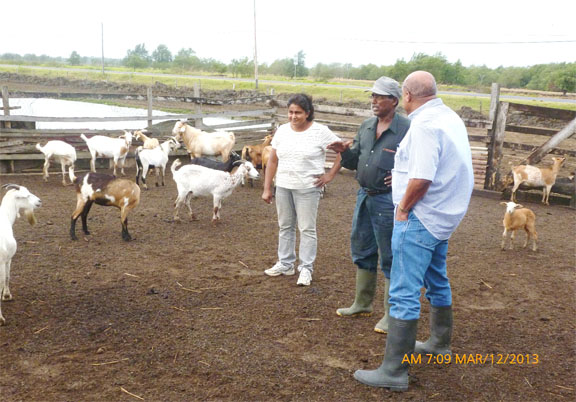The West Berbice Sheep & Goat Association is widely believed to be the best-organised agricultural grouping of its kind in Guyana.
Established in 2007, the group’s 60 members reside in communities that extend from Profitt to Rosignol.
There are set criteria for membership, one of which is proof of ownership of at least five head of sheep and/or goats.
What keeps the association together is the desire of its members to enhance the reputation of West Coast Berbice as the major area in the country for the breeding of ruminants. The farmers benefit from some measure of training in sheep development and sheep and goat management. They have also visited farms in other parts of the country. These trips have allowed them to gather and share information and expertise with other farmers.
Much of the training has been the result of the collaborative efforts of the Rural Enterprise Agricul-tural Development (READ) Project being overseen by the Ministry of Agriculture and the Guyana Livestock Development Authority (GLDA) which came into being a year ago. Training and field trips apart, members have also benefited from grants designed to help enhance their stocks and increase production.
Critically, the members of the association have also benefited from training in the development of business plans and general farm management. The training is critical particularly given the fact that many of the farmers had had no prior experience in or exposure to managing a business.
Currently, most of the members of the group rear sheep only. However, they are poised to expand into goat-rearing though prior investigations must be undertaken to determine the suitability of the prevailing conditions.

The challenge of this potentially lucrative industry reposes in a lack of market information. Sales of mutton and goat meat are known to peak during particular periods, but statistics on the extent of either the demand or the volume of goat meat produced in Guyana are unreliable, and probably unavailable. Mutton retails at approximately $700 per pound, while live sheep can be bought at around $400 to $500 per pound. The farmers are awaiting the fruition of plans to create mobile stalls at Mon Repos Market.
Steeped in the rearing of sheep and goats, the members of the association are not inclined to shift from what they regard as a tradition. They say, however, that they need more incentives to keep their interest in the industry alive. Land for grazing and an injection of new breeding animals are among the incentives which they hope will be forthcoming from the state.
To date most members of the association are part-time goat and sheep farmers. They must retain alternative means of livelihood. They rear other livestock and cultivate rice and cash crops. Others work as labourers or public servants.
A key event on the farmers’ calendar is the Sheep and Goat Festival where mutton and goat meat are promoted as the healthiest of the family of meats available on the local market.
Scarcity of grazing pastures has led to other problems. The animals must occupy open lands and parapets in housing areas, a circumstance that leads to disputes with residents. Sometimes animals are impounded. It costs $8,000 and $10,000, respectively, to have a sheep or goat released from the pound. Livestock thieves (rustlers) and vicious stray dogs are also a threat to the sheep and goats.










